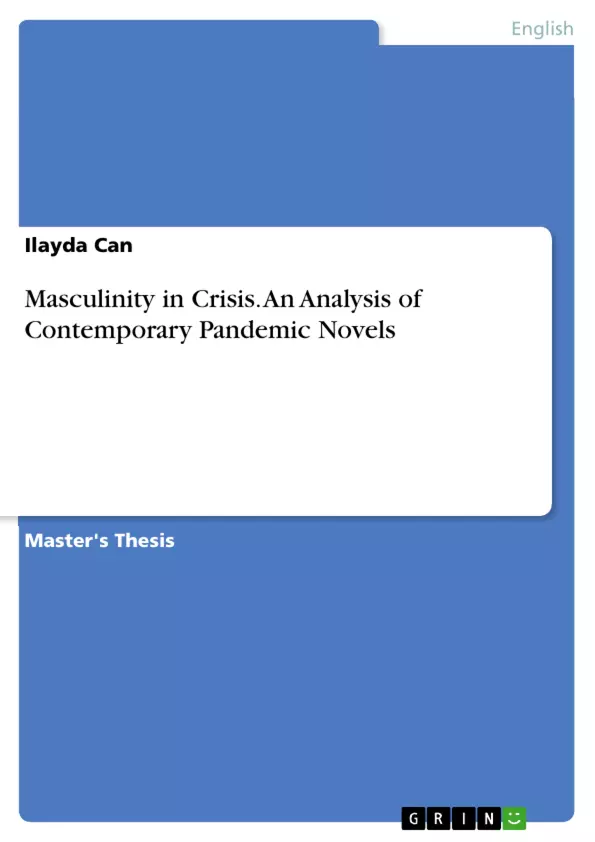The objective of this thesis is to examine the portrayal of masculinity in contemporary pandemic novels. Specifically, it aims to highlight the positive aspects of male characters and counteract their general neglect. It will also explore how men's private and public performances during a pandemic impact society.
The thesis begins with an introduction outlining the context of the COVID-19 pandemic and society's response to it, highlighting the role of pandemic fiction as an analogy and familiar routine in times of crisis. It then argues for the necessity of examining the representation of masculinity in pandemic fiction, as existing research predominantly addresses feminist theories, with the analysis of men being either secondary or nonexistent. It also emphasizes the need to consider both negative and positive aspects of masculinity. The thesis then discusses the definition of 'masculinity' and highlights the necessity of rereading literature from a male perspective. It investigates the portrayal of masculinity in the novels 'Station Eleven' by Emily St. John Mandel, 'Severance' by Ling Ma, and 'The End of Men' by Christina Sweeney-Baird, focusing particularly on the impacts of men's private and public performances during the pandemic. Finally, it stresses the necessity of a complete examination of gender dynamics to broaden the definition of masculinity and challenge patriarchal norms.
Table of Contents
- 1. Introduction: Approaching Masculinity in Pandemic Novels
- 2. Theoretical Backgrounds
- 2.1 Masculinity and Its Behavioral Characteristics
- 2.2 Literary Viagra: The Rise of Male Suffering in (Pandemic) Literature
- 2.3 Literature and Masculinity: Masculinity from a Reader's Perspective
- 2.4 Hegemonic Masculinity, Subordinate Variants, and Healthy Masculinity
- 2.5 Male Dominance and Violence: A Prejudice-Based Concept?
- 2.6 Patriarchy: The Origin of Violence Against Women?
- 2.7 Misandry vs. Misogyny – WoMen Shooting at WoMen
- 3. Arthur and Tyler Leander's Embodiment of Masculinity in Emily St. John Mandel's Station Eleven
- 3.1 Introducing Father and Son and their Behavioral Characteristics
- 3.2 Divergence of Male Suffering: The Negative Effects of a Strained Relationship between Father and Son
- 3.3 Exploring Arthur's Type of Masculinity
- 3.4 Exploring Tyler's Type of Masculinity
- 3.5 Arthur's Renunciation of Violence vs. Tyler's Use of Structural and Psychological Abuse
- 3.6 Perceiving Father and Son: Arthur as a Victim of Philandry and Tyler's Misogynistic Attitude
- 3.7 The Impact of Arthur's and Tyler's Public Acts on Their Masculinity and Pre- and Postapocalyptic Society
- 3.8 How the Psycho-Narration Affects the Perception of Arthur and His Masculinity
- 4. Ling Ma's Input to Masculinity in Severance
- 4.1 Introducing the Post-Pandemic Hunter Bob and Candace's Third Uncle
- 4.2 Male Fragility and Discontent in Adulthood After and Before the Shen Fever Outbreak
- 4.3 Exploring Bob's Type of Masculinity
- 4.4 Exploring the Third Uncle's Type of Masculinity
- 4.5 The Causes of Violence Before and After the Pandemic
- 4.6 Bob and the Third Uncle Inciting Misandry
- 4.7 How Bob's and the Third Uncle's Private Acts Affect Their Masculinity and the People around Them
- 4.8 The Effect of Anaphoras in Direct Speeches by Bob and the Third Uncle
- 5. Targeting Men: Representations of Masculinity in Christina Sweeney-Baird's The End of Men
- 5.1 The Decline of Men Like Anthony and Mikhail: Introducing Male Characters and Their Behavioral Characteristics
- 5.2 Silencing Anthony and Mikhail: How the Male Characters Suffer
- 5.3 Exploring Anthony's Type of Masculinity Based on His Lifestyle
- 5.4 Exploring Mikhail's Type of Masculinity Based on His Lifestyle
- 5.5 The Absence of Violence in Anthony's Life vs. Mikhail as the Male Perpetrator
- 5.6 Perceiving the Male Characters with Philandrous and Misandrous Tendencies
- 5.7 The Impact of Private and Public Acts on the Characters' Masculinity and Society
- 5.8 Sweeney-Baird's Narrative Techniques of Characterization of Anthony and Mikhail
- 6. Conclusion: Comparing Male Identities
Objectives and Key Themes
This thesis investigates the portrayal of masculinity in contemporary American pandemic novels. It aims to analyze how male characters in these novels are constructed and how their experiences of masculinity are shaped by the pandemic. The research focuses on the intersection of masculinity, societal expectations, and the impact of the pandemic on individual lives.
- The impact of the pandemic on masculinity
- The portrayal of different types of masculinity in contemporary literature
- The role of violence and aggression in shaping masculine identity
- The relationship between masculinity and societal power structures
- The complexities of male characters' experiences and emotions
Chapter Summaries
The thesis begins by exploring the theoretical background of masculinity in literature, examining various theories on masculinity, male suffering, and gender studies. It then analyzes three novels: Station Eleven by Emily St. John Mandel, Severance by Ling Ma, and The End of Men by Christina Sweeney-Baird. Each chapter focuses on the portrayal of masculinity in a specific novel, examining how the characters embody different types of masculinity, how they navigate societal expectations, and how their actions impact their relationships and the world around them.
Keywords
The primary focus of this thesis lies in analyzing how male characters navigate masculinity in pandemic novels. Key concepts include masculinity, male suffering, violence, societal expectations, gender studies, and the impact of the pandemic on individual lives. The analysis focuses on the specific novels Station Eleven, Severance, and The End of Men, exploring the different types of masculinity presented within each work.
- Quote paper
- Ilayda Can (Author), 2022, Masculinity in Crisis. An Analysis of Contemporary Pandemic Novels, Munich, GRIN Verlag, https://www.grin.com/document/1383247



